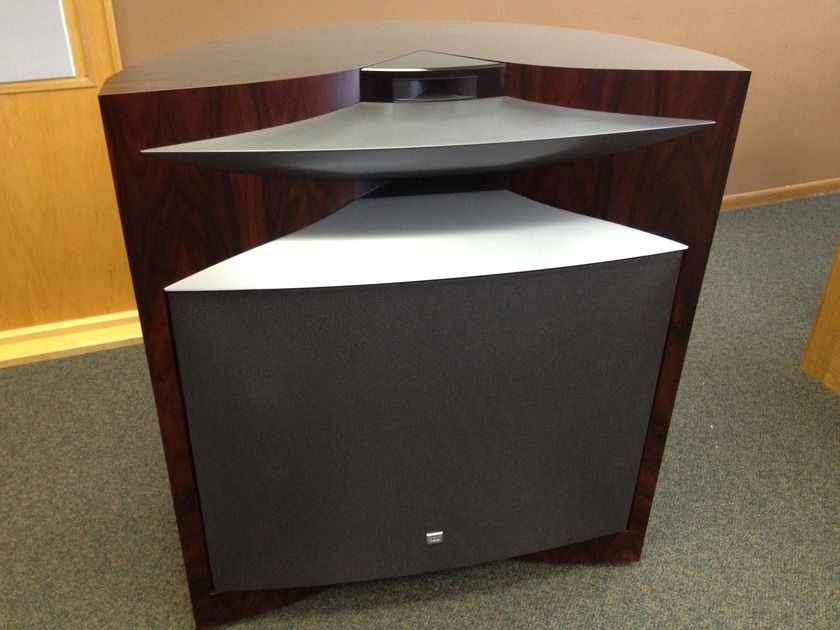Part II cause we're limited around here! :thmbsp:
The system I used with the big KEF's comprised the Meridian 508.24 for CD replay and the Linn for vinyl. These were coupled with the Pass Labs phono stage, Primary line stage and mono blocks, which rose to the occasion admirably. It is rare that I'm able to safely unleash over 300 watts into any loudspeaker but it was clear that the Maidstone's were having a good time with them. Connections were made with Chord Company Chorus and Odyssey which did sterling service. Towards the end of the listening, and feeling the demand to try something a little more exotic (and in keeping with a twelve grand speaker) I prised a set of the ruinously expensive Nordost SPM from the editor's sticky grasp. And yes, it made a big difference, building on the already impressive performance.
The Maidstone's need plenty of space around them which was no problem fore and aft but unfortunately in my room I could not quite give them the clearance they deserved to the sides. They constantly reminded me of the fact, so be warned, you will need a lot of space.
The first thing you notice about the sound of the Maidstone's is the sheer, enormous scale that they present. There is an impact to music that a good large speaker can provide by way of a combination of dynamics, bandwidth and effortlessness that can be totally addictive. The Maidstone's are good. There is a sure footedness to their presentation that instils a confidence not available from lesser designs. To be more specific, the Maidstone puts all the fundamentals in the right place, and at the right time, with such authority that all other aspects of the performance fall into place.
Rhythmically complex music, such as Peter Gabriel's soundtrack to The Last Temptation of Christ is conveyed in a fashion that leaves no doubt as to who is in control. The drummers, all twenty of them! As the music builds up, and each successive layer of percussion is added, there has been a sense of doubt with many systems that they might lose the plot or even their bass units when things start getting frantic. Not so with the Maidstone's. I have never heard a speaker remain so totally in control with this music, even at really frightening levels. They manage to pass it off with a slight sense of arrogance as in "is that the best that you can do?" No problem. There is something about the combination of the two bass units that gives music of this sort both the weight and agility which makes it so exciting. In my experience a single large bass driver cannot successfully deliver both of these qualities. Likewise, large scale orchestral works such as Brahms' Symphony Nos. 3&4' are beautifully reproduced, again with that sensation of immense scale countered with poise, and where called for, drama. It was impossible for me to listen to just one movement, I had to play the whole thing through. By contrast, small scale recordings such as the Shostakovitch string quartets (all of them!) were reproduced with an intimacy that was enthralling, combined with a lush but accurate string tone, built on the resonant presence of the instrumental bodies. Although there was plenty of depth, the Maidstone's found it difficult to define a convincing lateral image of the instruments, resulting in a lack of precision across the soundstage.
Traditionally the Uni-Q drivers have excelled at image definition, to the extent that it wasn't essential to be square in the middle of the loudspeakers. This is where I suspect that the width of the room was upsetting the situation but unfortunately I didn't have the opportunity to try them in a wider one. Besides, moving them would have been a nightmare! I have heard them produce lateral images (although not of the exaggerated, pinpoint variety so fashionable at present), so this will have to remain a 'listen to them in your own room' judgement.
A session which remains highlighted in my memory of these loud-speakers occurred late one night, listening to the Naxos recording of Arvo Part; Fratres. This eerie music has a quiet, pensive beginning which grows to a thunderous dynamic crescendo before dying down again, all within the first movement. It is intensely emotional stuff, and I was left enthralled and not a little scared, particularly as I was in the house alone.
As you will probably gather, I was enjoying myself. I had to force myself to explore some of the other possibilities using ancillary equipment that I had on hand, because every time I went into the room I just wanted to listen to more music. I did get round to bi-amping the Maidstone's with two Naim NAP 250's, and this proved to be a good match, sounding a little tidier and more controlled, although lacking the drama and sense of scale that the Primary valve amps could generate. The attributes of the Naim amplification shone through, with good rhythmic delivery and timing. I began to wonder what four NAP 135's would sound like... but there just wasn't time, and by this stage I felt as if I already had a good feel for the KEF's capabilities.
There is no doubt that the Maidstones are remarkable. Like any esoteric product, they demand skill and patience in setting up, and the choice of suitable amplification is certainly a limited one. Yet again we are confronted with a product that demands the agility and subtlety of a small amplifier combined with the sheer muscle and current drive of a much larger unit. Fortunately because they work so well with bi-amplification, this dichotomy is not the problem it might otherwise be. Similarly they are demanding of the room. These loudspeakers excel at presenting music on a large scale and in order to achieve their full potential they need plenty of space to breathe.
Have KEF met their design objectives? Yes, I believe they have. The Maidstone's did all the things that you would expect a large loudspeaker to do and with supreme confidence. Are they value for money? I just don't know. That depends on your particular outlook and circumstances, I know that I spent as much time as I possibly could listening to the Maidstone's, and when the time came for them to go I realised that there was going to be a considerable period of readjustment. I still miss them.









